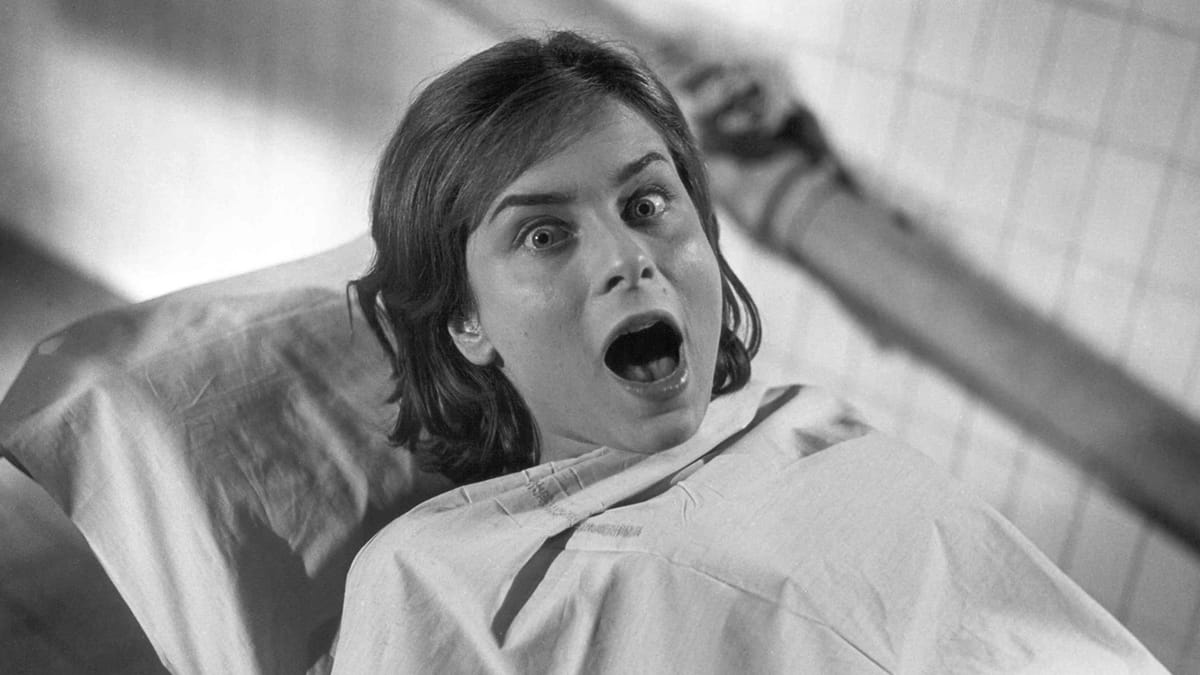Irreversible Damage: Eyes Without a Face (Georges Franju, 1960)
Trying to fix your weird kid, one stapled-on corpse face at a time.

I do not know what possessed me to read Irreversible Damage this month. I’d been writing about trans kids, especially after Nex Benedict’s death, and I figured that I should study how they’re being discussed. Know your enemy, and all that.
If there’s one thing that will not cheer you up, right after a child’s death, it’s a book-length manifesto on why we need to abuse more children. This is particularly true when the book is laced throughout with statements about how transmasculine bodies (so, my body, among others) are terrifying and disgusting.
Testosterone will “permanently alter your daughter’s facial features, enlarge her clitoris, leave her covered in body hair, and perhaps render her infertile.” Vaginas after testosterone are prone to “dryness, cracking and recession,” while the clitoris “grows to the size of a baby carrot.” Phalloplasty makes your dick rot off. Even taking a graft off someone’s forearm turns out to be a gorefest: “I may never shake the image of a young girl’s [sic] forearm harvested for phalloplasty — shucked of skin, fat, nerve and artery. A tissue-thin remnant of wrinkled skin, shrink-wrapped to the bone.”
Obviously, I know that some people consider my body weird. If that were enough to keep me from transitioning, I would never have transitioned. Plenty of the people I see on the street look weird to me; I don’t walk up to them and tell them so, and I also expect that lots of them have partners who find them hot and love them to death. Attraction isn’t decided by popular vote. Not wanting to sleep with somebody doesn’t mean anything except that I, personally, don’t want to sleep with them. Most grown-ups manage to figure that one out.
I also know that the theatrical disgust cis people adopt when talking about trans bodies often masks sexual curiosity. I am hardly the first person to point out that this seems to happen a lot in Irreversible Damage. Abigail lingers at length on the toned physiques of young transmasculine YouTubers, and at one point, finds herself getting thirsty for Buck Angel: His “t-shirt stretched over his impressively muscled arms,” and yet, “in his soft eyes, the lightest shade of blue, I met a gentleness that won me over.”
Oh, my. Let us draw a veil over this scene, and Abigail’s sudden craving for baby carrots. The point is: All the abuse Shrier recommends over the course of this book (one of her best-case scenarios involves a child being pulled out of school and sent to work without pay for a farm, where “the physical labor helped her [sic] reconnect to her body;” I guess that’s one way to put it!) is meant to help parents avoid the apparently terrible fate of having a child who doesn’t look normal. It seems as if it could not possibly be that simple, or that stupid. Yet there it is.
One thing reading about trans history will do for you is to make you acutely aware of the terrible power the “normal” body exercises. For the most part, “normalcy” has been determined by doctors, who are working from an ideal that does not exist in nature. Tremendous violence has been inflicted — often, though not always, on children or babies — to make real people fit that mold.
In Histories of the Transgender Child, for instance, Jules Gill-Peterson writes that many of our technologies for altering gender presentation were developed by experimenting on intersex children. The experiments were physically painful, non-consensual, and often horrific, involving gland excisions, clitoridectomies, and other invasive procedures. The child could not refuse, nor could it decide which gender it would be assigned. In one case, a child who had been “reassigned to a sex that contradicted their sense of self” had to be referred to an eye doctor after the operation; though the eye doctor found nothing wrong, Gill-Peterson writes, “the recorded complaint… was that this child’s ‘eyes tear’ constantly. Apparently the doctors could not imagine that constant crying might have been a traumatic effect of their aggressive medical protocol.”
I doubt Abigail Shrier knew any of this when she set out to write her book. I doubt it matters. Prejudices like these run so deep, and are so taken for granted, that you don’t really need to know about them in order to pass them on. It’s just an image, a recurring nightmare, buried in the popular consciousness: The child, locked up, alone, hidden from the world, as its parents slice away at it a piece at a time to make it normal again.